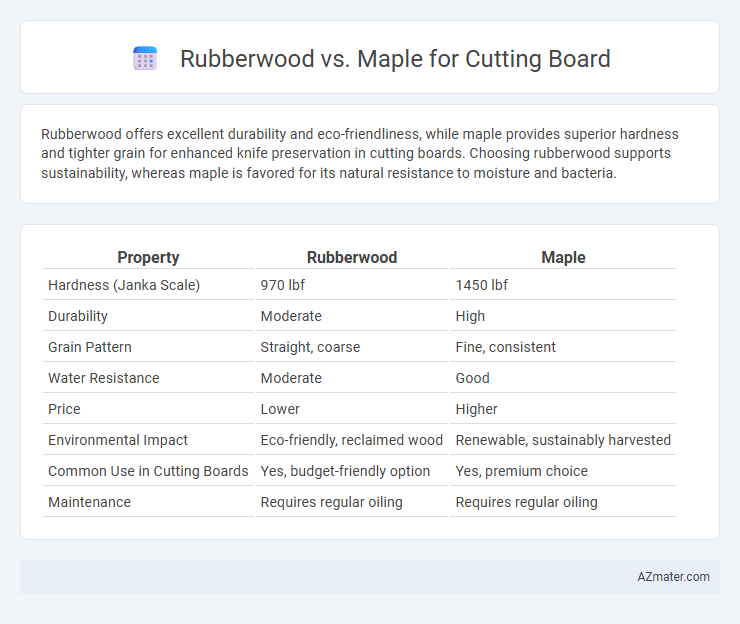Rubberwood offers excellent durability and eco-friendliness, while maple provides superior hardness and tighter grain for enhanced knife preservation in cutting boards. Choosing rubberwood supports sustainability, whereas maple is favored for its natural resistance to moisture and bacteria.
Table of Comparison
| Property | Rubberwood | Maple |
|---|---|---|
| Hardness (Janka Scale) | 970 lbf | 1450 lbf |
| Durability | Moderate | High |
| Grain Pattern | Straight, coarse | Fine, consistent |
| Water Resistance | Moderate | Good |
| Price | Lower | Higher |
| Environmental Impact | Eco-friendly, reclaimed wood | Renewable, sustainably harvested |
| Common Use in Cutting Boards | Yes, budget-friendly option | Yes, premium choice |
| Maintenance | Requires regular oiling | Requires regular oiling |
Introduction to Rubberwood and Maple Cutting Boards
Rubberwood cutting boards are made from the hardwood of the Para rubber tree, known for its durability, eco-friendliness, and resistance to knife marks, making it a sustainable choice for kitchen use. Maple cutting boards, particularly those crafted from sugar or hard maple, are prized for their dense grain structure and natural antimicrobial properties, offering a smooth surface that withstands heavy chopping and resists bacteria. Both materials provide longevity and safety, with rubberwood emphasizing sustainability and maple valued for its classic, resilient cutting surface.
Material Origins: Rubberwood vs Maple
Rubberwood, sourced from the Para rubber tree (Hevea brasiliensis), is a sustainable hardwood harvested after latex extraction, making it an eco-friendly option for cutting boards. Maple, primarily derived from sugar maple trees (Acer saccharum), is a dense hardwood renowned for its durability and fine grain, often used in high-quality kitchenware. Both materials offer distinct benefits, with rubberwood emphasizing sustainability and maple excelling in hardness and food-safe properties.
Durability Comparison: Which Lasts Longer?
Rubberwood is moderately durable but more prone to scratches and water damage compared to maple, which is naturally dense and resistant to wear. Maple's tight grain structure makes it less susceptible to knife marks, ensuring a longer lifespan for cutting boards. Choosing maple results in a cutting surface that maintains integrity and smoothness over extended use, offering superior longevity.
Knife-Friendliness: Protecting Your Blades
Rubberwood is known for its moderate hardness, providing a knife-friendly surface that helps protect blade edges from dulling quickly, making it ideal for cutting boards. Maple, especially hard rock maple, offers a tight grain structure that is gentle on knives, combining durability with excellent resistance to knife marks. Both woods strike a balance between durability and blade preservation, but rubberwood's slightly softer texture typically results in less wear on cutting edges over time.
Maintenance and Care Requirements
Rubberwood cutting boards require regular conditioning with mineral oil to prevent drying and cracking, as their porous nature makes them more susceptible to moisture absorption. Maple boards, known for their dense, tight grain, are naturally more resistant to bacteria and easier to maintain with simple hand washing and periodic oiling. Both materials should avoid prolonged water exposure and dishwashers to preserve their structural integrity and longevity.
Hygiene and Food Safety Considerations
Rubberwood cutting boards offer natural resistance to bacteria due to their dense grain structure, making them a hygienic choice for food preparation. Maple, known for its tight grain and antimicrobial properties, is highly effective in preventing bacterial growth and is frequently recommended for cutting boards in professional kitchens. Both woods require proper cleaning and drying to maintain food safety, but maple's enhanced resistance to moisture absorption generally leads to better long-term hygiene.
Environmental Impact and Sustainability
Rubberwood, derived from rubber trees nearing the end of their latex-producing life, offers a renewable and eco-friendly option for cutting boards by utilizing wood that would otherwise be discarded. Maple, while a durable hardwood commonly used in cutting boards, involves slower growth rates and less efficient resource use, impacting its sustainability compared to rubberwood. Choosing rubberwood supports sustainable forestry practices and reduces deforestation, making it a greener choice for environmentally conscious consumers.
Aesthetic Appeal: Grain, Color, and Finish
Rubberwood cutting boards feature a light, creamy color with subtle, straight grain patterns that offer a clean, modern aesthetic suited for minimalist kitchens. Maple cutting boards display a tight, fine grain with a warm, natural yellow to reddish hue that deepens with age, enhancing rustic and traditional kitchen decor. Both woods accept finishes well, but maple's denser grain allows for a smoother, more polished surface that highlights its rich color variations.
Price and Value for Money
Rubberwood cutting boards typically offer a more affordable price point compared to maple, making them a budget-friendly option without sacrificing durability. Maple cutting boards are known for their high density and resistance to knife marks, providing long-term value despite a higher initial cost. Choosing between rubberwood and maple depends on balancing upfront investment with desired longevity and maintenance preferences.
Which Wood Should You Choose for Your Cutting Board?
Rubberwood offers a sustainable, affordable option with a moderate hardness of around 1000 Janka, making it resistant to knife marks while being eco-friendly. Maple, particularly hard maple (sugar maple), boasts a higher hardness of about 1450 Janka, providing superior durability and natural antibacterial properties ideal for cutting boards. For longevity and food safety, hard maple is often the preferred choice, although rubberwood serves as a budget-friendly, environmentally conscious alternative.

Infographic: Rubberwood vs Maple for Cutting Board
 azmater.com
azmater.com